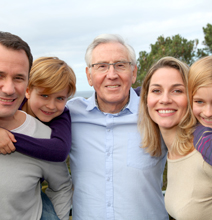Learn about your family risk
FAMILIAL HISTORY AND DISEASE RISK
Learning about your familial history of breast cancer is nothing more than understanding how the disease has affected your family, and if there are any signs of a possible hereditary component.
Because we are talking about genes there are some considerations to take into account when looking at your family history of cancer.
They aim to help you understand what information and what relatives would be relevant for your familial history of cancer:
Two family branches, two independent family histories
When you think about familial history of cancer, always analyze separately the two sides of the family, in other words those not linked by blood.
In hereditary syndromes of breast cancer, both men and women can carry the mutation and develop the disease. Unless there is consanguinity, cases in the mother’s family (in the maternal side) are not linked to those in the father’s family (paternal side) because there are no exchanged or shared genes.
Close versus distant relatives
Start by collecting information on your close relatives.
The most relevant family for your history will be first-degree relatives (parents, siblings and children). Only after that, you should look into 2nd degree relatives (grandparents, uncles and aunts, grandchildren, nephews and nieces). And finally, collect information from more distant family members.
By the end, you should be at the center of a family history tree that unfolds around you.
Next generation
Do not forget to include information on your children and grandchildren.
They can provide important clues for your family history.
Your children and grandchildren are your genetic descendants, so your history will be also important for their future health.
Blood/biological relatives
The genetic history of a family should only include blood relatives; they are the only ones sharing our genetics.
IMPORTANT:
- Relatives by marriage (husband/wife), or adoptive children do not have a biological or genetic connection with the family. They could be important, however, if they have a family history of related cancers, in which case there might be a shared environmental influence.
- A half-sister/brother is not a 1st but 2nd degree relative.
Important information to list
It is time to register the important information on your family history of the disease.
Take note of:
- Relatives affected by cancer
- Healthy relatives
- In those individuals that developed cancer, in which organ did the disease first starts?
- At what age was diagnosis done? Before the age of 50?
(early disease suggests hereditary cancer) - Is there any other clinical indication that the disease could be hereditary?
(for ex. bilateral breast cancer – when both breast are affected – tend to be hereditary)
Several criteria indicate high-risk of familial breast cancer - if any of these are present in your history, the hypothesis of a hereditary syndrome should be thorough investigated.
Collect your family data and check that possibility using the application to construct your history .
The next step is to see your family doctor; he/she is now the person right person to help you.





